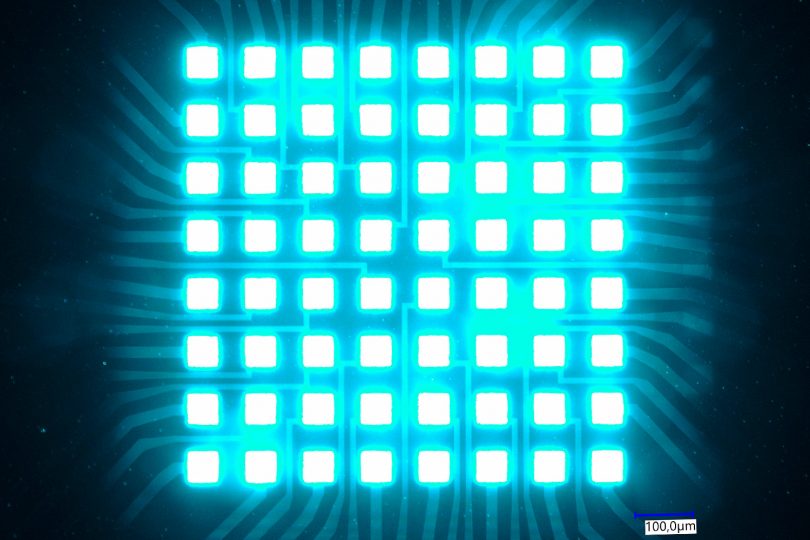Booster for collaborative quantum computer development New ATIQ project funded by the Federal Ministry of Research has a total volume of 44.5 million Euros
Quantum computers promise unprecedented computing power for applications where data processors based on “zeros and ones” can only fail. 25 partners from research institutes and industrial partners are now developing quantum computer demonstrators in the “Trapped-Ion Quantum Computer for Applications” (ATIQ) project which are implemented together with users of quantum computers. The partners are tackling major technical challenges in order to implement German quantum computer demonstrators and to make them available to users for a 24/7 operation. The Federal Ministry of Research is funding the project with 37.4 million Euros.
It is ATIQ’s goal to develop a first generation of reliable, user-friendly quantum computer demonstrators based on ion trap technology that are available around the clock within 30 months. To this end, the leading groups in ion trap research at the universities of Hanover/ Braunschweig, Siegen and Mainz have joined forces with research institutions and industrial partners.
“We want to take the next big step together. ATIQ is supposed to be the focal point for a German ecosystem of ion trap quantum technology bringing together technology partners, science and users resulting in relevant commercial utilization,” summarizes project coordinator Prof. Dr. Christian Ospelkaus from Leibniz University Hannover and the Physikalisch-Technische Bundesanstalt Braunschweig the motivation for this project.
Robust and scalable quantum hardware
Indeed, ATIQ has enormous potential for economic and scientific success. Quantum computers promise unprecedented computing power for applications where classic high-performance computers by themselves fail completely. The combination of classic high-performance computers and quantum computers, on the other hand, opens up completely new applications. There is therefore an urgent need for Germany to provide robust and scalable quantum hardware. The ATIQ consortium aims to optimize hardware for chemical applications. Novel chemical substances and the reactions for their synthesis could be simulated on quantum computers. Another possible application might be in finance where completely new avenues are being explored in credit risk assessment.
While ion trap technology is considered one of the two most promising paths to quantum computing. However, current systems are complex laboratory machines, continuously maintained and calibrated by highly skilled personnel. Running quantum algorithms as an external user without constant supervision by experts will only be possible with more reliable components. To this end, the ATIQ partners want to take the control of the processors with electronic and optical signals and the interaction with conventional supercomputers to a new level. The strength of the consortium here is not only their world-leading knowledge as developers of ion trap technology and fundamentals, but also the collaboration of already existing networks, such as within the Quantum Valley Lower Saxony.
“We are excited to contribute to the development of quantum computers with our enabling technologies. With the research center LENA and the Epitaxy Competence Center ec², the three participating institutes of the TU Braunschweig (Institute of Semiconductor Technology, Institute of Electrical Measurement Science and Fundamental Electrical Engineering, Institute for CMOS Design) can draw on an excellent infrastructure for this,” says Professor Andreas Waag, spokesman of the Laboratory for Emerging Nanometrology (LENA) at the TU Braunschweig
About the project
The joint project “ATIQ – Trapped-Ion Quantum Computer for Applications” is part of the BMBF funding measure “Quantum Computer Demonstration Setups”. Project duration is December 1, 2021 until November 30, 2026. 3.2 million euros of the project volume of 44.5 million euros (BMBF funding of 37.4 million plus the participating companies’ own contribution) will go proportionately to the TU Braunschweig.
A total of 25 partners have joined forces in the network. In addition to the coordinating Leibniz Universität Hannover, the partners are JGU (Johannes Gutenberg University Mainz), University of Siegen, RWTH Aachen, Physikalisch-Technische Bundesanstalt, Fraunhofer-Gesellschaft, AMO GmbH, AKKA Industry Consulting GmbH, Black Semiconductor GmbH, eleQtron GmbH, FiberBridge Photonics GmbH, Infineon Technologies AG, JoS QUANTUM GmbH, LPKF Laser & Electronics AG, Parity Quantum Computing Germany GmbH, QUARTIQ GmbH, Qubig GmbH and TOPTICA Photonics AG. Associated partners are AQT Germany GmbH, Boehringer Ingelheim, Covestro AG, DLR-SI, Volkswagen AG and QUDORA Technologies GmbH.

